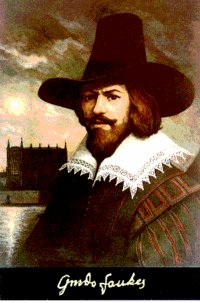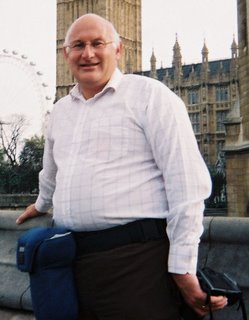
Tomorrow, November the fifth, is when we celebrate Bonfire Night or Guy Fawkes Day. As most people now only have a skimpy idea about the Gunpowder Plot, I thought it might be interesting to outline the main story behind it. This year marks the 400th anniversary of the plot.
The PlotIn 1605, Guy Fawkes (also known as Guido - yes, really) and a group of conspirators attempted to blow up the Houses of Parliament.
After Queen Elizabeth I died in 1603, English Catholics who had been persecuted under her rule had hoped that her successor, James I, would be more tolerant of their religion. James I had, after all, had a Catholic mother. Unfortunately, James did not turn out to be any more tolerant than Elizabeth and a number of young men, 13 to be exact, decided that drastic action was the only answer.
A small group took shape, under the leadership of Robert Catesby. Indeed, he felt the best thing to do was to blow up the Houses of Parliament. In doing so, they would kill the King, maybe even the Prince of Wales, and the Members of Parliament who were making life difficult for the Catholics.
Today these conspirators would be known as extremists, or terrorists!To carry out their plan, the conspirators got hold of 36 barrels of gunpowder - and stored them in a cellar, just under the House of Lords.
But as the group worked on the plot
, it became clear that innocent people would be hurt or killed in the attack, including some people who even fought for more rights for Catholics. Some of the plotters started having second thoughts. One of the group members even sent an anonymous letter warning his friend, Lord Monteagle, to stay away from the Parliament on November 5th,
but was the letter real?The warning letter reached the King, and the King's forces made plans to stop the conspirators.
Guy Fawkes, who was in the cellar of the parliament with the 36 barrels of gunpowder when the authorities stormed it in the early hours of November 5th. He was caught, tortured and executed for treason.
However, it is unclear if the conspirators would ever have been able to pull off their plan to blow up the Parliament even if they had not been betrayed. Some have suggested that the gunpowder itself was so old as to be useless. Since Guy Fawkes and the other conspirators got caught before trying to ignite the powder, we'll never know for certain.
Even for the period which was notoriously unstable, the Gunpowder Plot struck a very profound chord for the people of England. In fact, even today, the reigning monarch only enters the Parliament once a year, on what is called "the State Opening of Parliament". Prior to the Opening, and according to custom, the Yeomen of the Guard search the cellars of the Palace of Westminster. Nowadays, the Queen and Parliament still observe this tradition.
On the very night that the Gunpowder Plot was foiled, on November 5th, 1605, bonfires were set alight to celebrate the safety of the King. Since then, November 5th has become known as Bonfire Night. The event is commemorated every year with fireworks and burning effigies of Guy Fawkes on a bonfire.
Some of the English have been known to wonder whether they are celebrating Fawkes' execution or honoring his attempt to do away with the government!
Was Guy Fawkes Framed?Was there really a Gunpowder Plot, or were the "conspirators" framed by the King?
There was no doubt an attempt to blow up Parliament on November 5th 1605. But Guy Fawkes and his associates may have been caught in a Jacobean sting operation which would have served the authorities by casting Catholics as an enemy to be pursued.
By the time Queen Elizabeth died, after ruling for about fifty years, most people only remembered living under her rule. When James I succeeded to the throne, many saw an opportunity for change. Those who felt particularly hard done by, both by Elizabeth I and James I, even felt that the situation was so bad as to require, in Fawkes' own words, "a desperate remedy": it was an opportunity to simply replace the current king.
These were unstable times indeed, with several smaller plots being discovered in the years preceding 1605. In fact, many of the Gunpowder plotters were known as traitors to the authorities. For this reason, it would have been difficult, if not unlikely, that they could gather 36 barrels of gunpowder and store them in a cellar under the house of Lords without the security forces getting suspicious.
Furthermore, the letter warning one of the members of government to stay away from Parliament is believed today to have been fabricated by the King's officials. Historians suggest that the King's officials already knew about the plot, that one of the plotters in fact revealed the key points of the plot to the authorities. The suspected turncoat? Francis Tresham.
The letter, then, would be a tool created by the King's officials to explain how, at the last minute, the king found out about the plot and stopped it just before it wreaked its havoc on Parliament and himself. At the same time, the letter was vague enough to give the officials all the latitude they wanted in falsifying confessions and to pursue their own anti-Catholic ends.
There are two fundamental problems with the letter:
Firstly, the letter was unsigned. Any and all of the conspirators, once apprehended, might have saved themselves from torture and perhaps even death if they could claim to have written it. None did. Not one of the conspirators who was caught appears to have known about the letter.
Secondly, the letter was very vague in its content. It said nothing about the details of the planned attack. Still, the king and his men knew exactly the where and when to catch the conspirators and stop the explosion just hours before it was to take place.
How did they know? Things don't change much in 400 years of politics.
Further details can be found on the
BBC website





